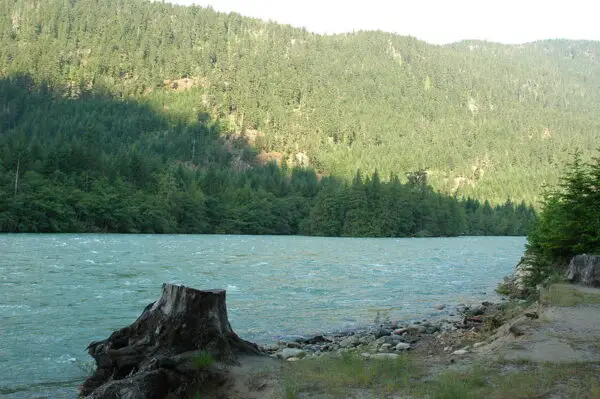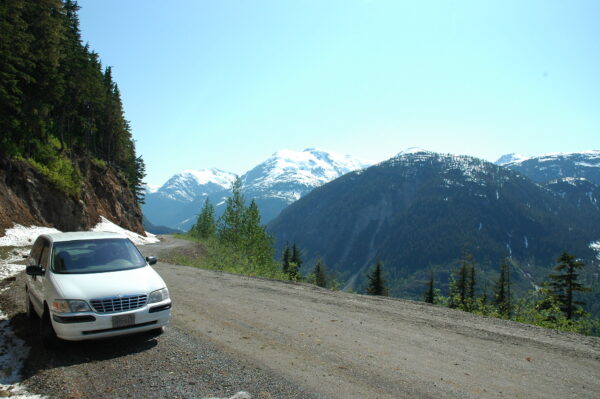British Columbia Forest Service Roads
There may come a time in your life when you realize that simply driving to work or around town is no longer thrilling. Or perhaps you’re somebody that actively enjoys nature (fishing, hiking, hunting, or natural hot springs), and really values being able to “get away from it all” on another level. This is when you might encounter a logging road in beautiful British Columbia.
These logging roads are also known as:
- Resource Roads
- Forest Service Roads
- Mineral Exploration Roads

What Are These Roads, Exactly?
These types of roads in beautiful British Columbia provide access to remote areas. They are not built to the same standards as highways.
These types of roads were created for industrial purposes, such as for logging, oil & gas, agriculture, mining. However, they are often used by us mere civilians to reach spectacular recreational and backcountry areas.
In addition, they provide a crucial link for rural communities.

How to Drive Safely on Resource / Logging Roads in BC
Research & Gather Your Gear
People often use these types of resource roads to escape civilization. This naturally translates into travelling beyond proximity of things like stores, gas stations, hospitals, restaurants, cell coverage, etc.
Research where you are headed and make sure you’ll have everything you need. Be sure to gear up with enough supplies as well as emergency items.

Be Aware of Road Rules
Be sure to drive to road conditions at safe speeds. In addition, stop only in safe, visible locations, and keep your headlights and taillights on.
- Drive safe speeds, according to road and weather conditions
- Obey the speed limit
- Never exceed 80km/hr
- Don’t call/text & drive
- Don’t drink & drive
- Wear your seatbelt
- Drive with head and tail lights on
- Yield to industrial traffic
- If you have to stop, stop in a safe, visible location
- Observe & obey road signs
- Drive on the right hand side of the road
- Have your driver’s licence & insurance
- Use caution – expect the unexpected
- Watch out for wildlife
- Extinguish all flames and sparks
- Report forest fires (*5555 on a cell)
- Pack it out – don’t litter
- Watch the road, dust = traffic
- Be observant – road conditions change rapidly
- Use the same rules as on the highway
Watch For Wildlife
Wildlife can be unexpected and unpredictable

Monitor Traffic
Resource roads can be narrow, potholed and rough, and overgrown roadside brush can limit visibility. Industrial drivers use two-way radios on specific channels to announce their approach and let others know to clear the way. If you have a two-way radio, it’s a good idea to tune in to the specific frequency, which is sometimes posted roadside.
Yield to industrial traffic
These large vehicles have a job to do, and they can’t manoeuvre as swiftly as passenger vehicles. Give them some space.

Have an Emergency Plan
Always plan ahead and be prepared. What could possibly go wrong?
- Weather can change very quickly
- Vehicles can break down
- People get lost
- First aid emergencies can happen
Make sure you know where you’re going, and what facilities and emergency services are available or near by. Make note of the emergency numbers for your area. The 911 service won’t necessarily work because it doesn’t work in all areas of the province.
It’s wise to complete a trip plan and provide it to a reliable person. Identify where you are going and when to expect to get back. Work together with that person to create an action plan in case you don’t return home at the planned time.
If you make any changes to your trip plan make sure that you let them know. If you are lost or stranded, stay with your vehicle; it will provide shelter until help arrives.
Often, it is easier for rescuers to find a vehicle than an individual in the woods.

What to Expect on Forest Service Roads BC
- Most resource roads have gravel surfaces and are narrow (often one lane wide)
- There may be roadside brush limiting visibility
- Soft shoulders
- Possibly and little to no ditch
- Roads will have more, tighter curves and road grades may be much steeper than regular highways
- There might not be signs identifying hazards
- There might not be barriers at dangerous or steep road sections
- You might encounter high traffic volumes
- Poor visibility due to smoke, dust or fog
- Passing or being passed on narrow roads
- Changing road surface conditions; freezing rain or snow
- Others failing to follow traffic control procedures
- Wildlife
- Other unmarked hazards

Other Vehicles
- Some industrial vehicles are very large, long and/or wide. You might need to clear out of the way. There might not be a pilot car ahead of large, long or wide vehicles.
- Yield to industrial traffic. Large industrial vehicles can’t manoeuvre as quickly as smaller passenger vehicles. Give these vehicles room so workers can safely do their job.
- As a cautionary approach, follow industrial vehicles at a safe distance – watch them, slow down and pull over if they do.
- Watch out for off road vehicles (ORV’s) ie. ATV’s, dirt bikes, etc. Be prepared for them to be around any corner. All ORV operators must follow the rules of the road including watching for and yielding to other traffic.

The Road Condition
Expect:
- Rough surfaces
- Potholes
- Sinkholes
- Washouts
- Water bars
- Cross ditches
- Damage might not be marked
- Roads might not be drivable
- Roads may may be overgrown or not ploughed – even though found on a map or GPS

Pull Outs
Most resource roads have pull outs built alongside the main driving surface. They may be located on either side of the road. It is okay to use a pull out on the left side… but only if there is no other place available and it is safe to do so. If you have a mobile radio, use it to advise other drivers that you are “clear”.

Bridges on Logging Roads
- Most bridges found on logging roads/resource roads are single lane
- Make sure you yield to oncoming traffic

Mobile Radio Use
Mobile radios are highly recommended for this situation, but not legally mandatory. If you are using one, plan ahead, know where you are travelling to, and have a radio shop program the right channels in your radio.
Observe and follow posted communication instructions.
If you don’t have a two-way radio, wait at the beginning of active haul roads for a vehicle that does; follow behind that vehicle, pulling over if it does. If you wait for some time and no vehicle comes proceed with extreme caution. Many people have been killed on these types of roads.

Speeds & Speed Limits
Some resource roads do not have posted speed limits. It’s the driver’s responsibility to travel speeds reflective of road conditions.
- If not otherwise posted, the maximum speed on a resource road in BC is 80 km/hr
- When limits are posted, you must obey them; these limits are enforceable
- Do not overtake industrial vehicles unless the driver pulls over and signals that it is safe to pass
- Take the time to plan your trip. Allow additional travel time so you will arrive on time or early to your destination
- Avoid travelling resource roads in the dark
- Don’t try to keep up
- Drive the speed appropriate for conditions, your knowledge and skill level
Smoking, Fires, Garbage, Vandalism
- Make sure you use an ash tray and thoroughly extinguish all flames, sparks and sources of ignition
- Keep trash inside your vehicle, look in the box of your pick-up to make sure there are no loose items that could fly out
- Pack it in, pack it out
- Signs are in place to ensure road user safety
- Do not damage signs or traffic control devices
Please report wildfires, littering, vandalism, suspicious activity and perceived environmental damage to the company responsible for maintenance (posted at the start of the road), the Ministry of Forests, Lands and Natural Resource Operations or Crime Stoppers.
My Experience With Forest Service Roads in BC
I’ve found myself on forest service roads several times in beautiful British Columbia. In Penticton, my dad and I attempted to drive one of the back roads that went from there to Kelowna.
But it was sort of a winter-y month, and half way through, there was a large frozen puddle / pot hole / type of thing in the middle of the road.
We actually had to turn around and go back, because we were sure our little Toyota Matrix at the time would not be into 4x4ing through that. We were sure the car would have become stuck. Sometimes you just have to admit defeat.
Another time my sister and I were seeking adventure to natural hot springs, and took a forest service road somewhere between here and the Yukon. Fortunately it was more summery this time.
We did not have a radio. But, we survived, and the hot springs at the end of the road were worth it. I admit we did not really plan ahead or research having a radio.
Conclusion
If I go again I will bring a radio for sure. I think people really do need a radio for those situations. There are fully loaded logging trucks, etc. that can hardly fit around curves even without other vehicles around. They are just trying to do their job safely, and having vehicles without radios in that situation can be dangerous.
These roads are serious, and not at all a place it would be fun to get into trouble. But, for true nature-lovers and people seeking adventure off the beaten path, these roads can deliver. Just remember that they exist because of industry, and are not tourist destinations. Yield to the truck in other words.
Frequently Asked Questions
Do I need a special licence plate to drive on these roads?
Answer: No.
Do I need a radio?
Answer: It’s recommended, but not legally mandatory.
Reference & Resources
- BC Forest Safety Council
- Resource Road User Safety Guide
- Resource Road Safety Video
- BC Search and Rescue Association
- ICBC Off Road Vehicles
- All Trails – Forest Service Roads in BC
- Video: Resource Road Orientation (YouTube)
- Video: Radio Use and Road Calling Procedures (YouTube)
- Pamphlet: Resource Road User Safety Guide (PDF, 1.2MB)
- Wildfire Reporting: 1-800-663-5555 OR *5555 on a cell
- BC Forest Safety Council: 1-877-741-1060
- Crime Stoppers: 1-800-222-8477
- Service BC: 1-800-663-7867
- Report all Poachers and Polluters (R.A.P.P.): 1-877-952-7277
- Emergency Management BC: 1-800-663-3456
- Natural Resource Violation Reporting: 1-844-676-8477